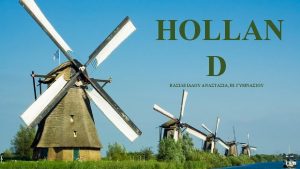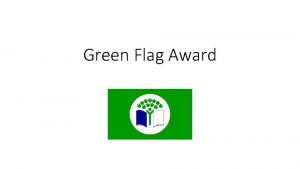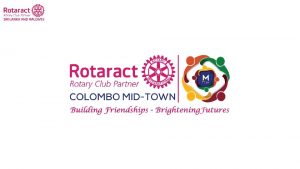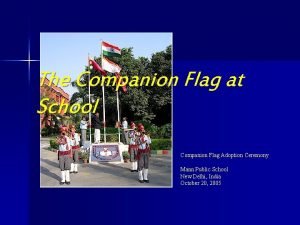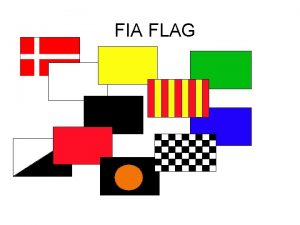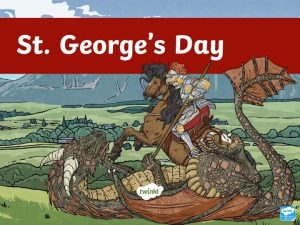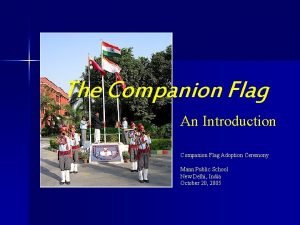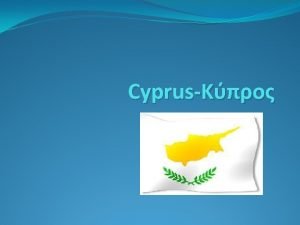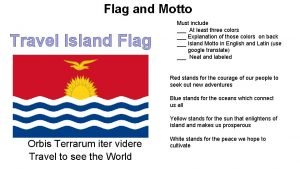THE FLAG OF HOLLAND HOLLAND IS FAMOUS FOR

















- Slides: 17


THE FLAG OF HOLLAND

HOLLAND IS FAMOUS FOR ITS COLOURFULL HOUSES!!!

PEOPLE OF HOLLAND GROW UP TOULIPS!!!

IN HOLLAND THE FESTIVAL OF ORANGES TAKES PLACE EVERY YEAR!!!


GEOGRAPHY HOLLAND IS LOCATED IN THE CENTRE OF EUROPE. SO, THERE A LOT OF CANNALS AND LAKES WHICH ATTRACT TOURISTS.

A CANNAL IN AMSTERDAM!! ! AMSTERDAM IS THE CAPITAL CITY OF HOLLAND!!!

HOLLAND’S AREA IS 41, 543 km² AND POPULATION IS 16, 929, 326 PEOPLE. IT HAD THE LARGEST PORT IN EUROPE, ROTTERDAM, BETWEEN 1962 AND 2004. The European part of the Netherlands borders GERMANY to the east, BELGIUM to the south, The largest and most important cities in the Netherlands are AMSTERDAM, The HAGUE an ROTTERDAM

• The Netherlands was the third country in the world to have an elected parliament, and since 1848 it has been governed as a parliamentary democracy and a constitutional monarchy, organised as a unitary state.

POLITICAL CULTURE • Both trade unions and employers organisations are consulted beforehand in policymaking in the financial, economic and social areas. They meet regularly with government in the Social-Economic Council. This body advises government and its advice cannot be put aside easily.

• The Netherlands has a long tradition of social tolerance. In the 18 th century, while the Dutch Reformed Church was the state religion, Catholicism, other forms of Protestantism, such as Baptists and Lutherans, and Judaism were tolerated but discriminated against.

• In the late 19 th century this Dutch tradition of religious tolerance transformed into a system of pillarisation, in which religious groups coexisted separately and only interacted at the level of government. This tradition of tolerance influences Dutch criminal justice policies on recreational drugs, prostitution, LGBT rights, euthanasia, and abortion, which are among the most liberal in the world.

MUSIC The Netherlands has multiple music traditions. Traditional Dutch music is a genre known as "Levenslied", meaning ‘’Song of life’’ , to an extent comparable to a French Chanson or a German Schlager. These songs typically have a simple melody and rhythm, and a straightforward structure of couplets and refrains. Themes can be light, but are often sentimental and include love, death and loneliness.

• Traditional musical instruments such as the accordion and the barre organ are a staple of levenslied music, though in recent years many artists also use synthesizers and guitars. Artists in this genre include Jan Smit, Frans Bauer and André Hazes. Since the 1990 s Dutch electronic dance music (EDM) conquered the world in many forms, from trance, techno and gabber to hardstyle.

• Some of the world's best dance music DJs hail from the Netherlands, including Armin van Buuren, Tiësto, Hardwell, Oli ver Heldens, Nicky Romero, Marti Garrix, Sander van Doorn and Afrojack; the first three of which have been ranked as best in the world by DJ Mag Top 100 DJs.

 Holland's flag
Holland's flag Densitet vatten
Densitet vatten Ministerstyre för och nackdelar
Ministerstyre för och nackdelar Jätte råtta
Jätte råtta Verktyg för automatisering av utbetalningar
Verktyg för automatisering av utbetalningar Tack för att ni lyssnade bild
Tack för att ni lyssnade bild Tillitsbaserad ledning
Tillitsbaserad ledning Vem räknas som jude
Vem räknas som jude Sju för caesar
Sju för caesar Nyckelkompetenser för livslångt lärande
Nyckelkompetenser för livslångt lärande Handledning reflektionsmodellen
Handledning reflektionsmodellen Verksamhetsanalys exempel
Verksamhetsanalys exempel Delegerande ledarskap
Delegerande ledarskap Stål för stötfångarsystem
Stål för stötfångarsystem Shivaismen
Shivaismen Cks
Cks Särskild löneskatt för pensionskostnader
Särskild löneskatt för pensionskostnader Kolposkopi px
Kolposkopi px
